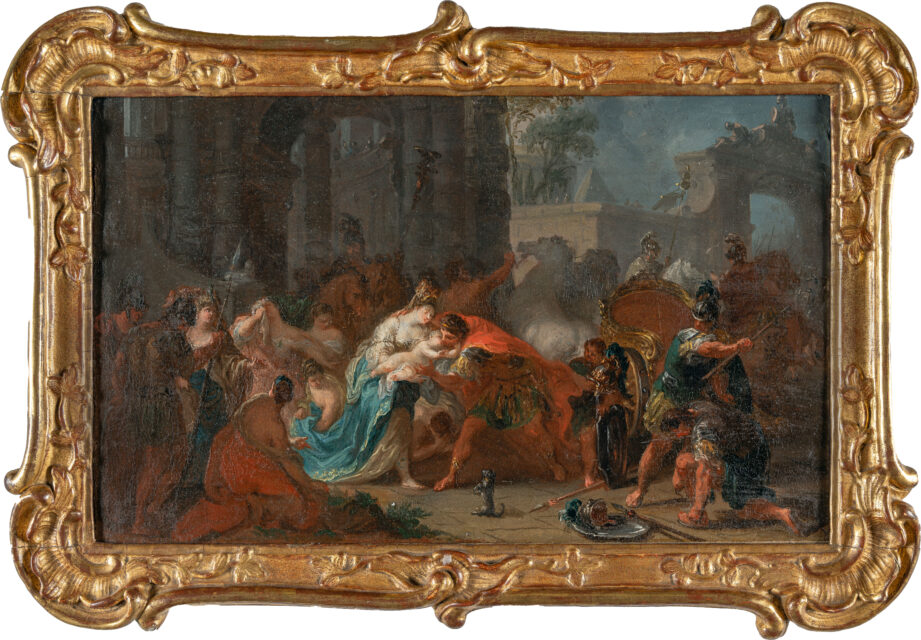Hector taking leave of his wife Andromache
Details
Literatur:
Christof Metzger und Julia Zaunbauer (Hrsg.), Götter, Helden und Verräter. Das Historienbild um 1800, Berlin 2023, S. 36, farb. Abb. 6, S. 38.
Provenienz:
Privatbesitz, Schweiz;
seit 2017 in Privatbesitz, Süddeutschland.
Descrizione
Franz Anton Maulbertsch, alongside Paul Troger the most important Austrian Baroque painter, adopted a sense of classicism with a love for antiquity at the end of his long life, but he did not paint in a Neoclassical way. In our small painting he tells of Hector’s farewell to his wife Andromache and his son Astyanax. Hector was the son of the legendary Trojan King Priam and the mythical hero who ultimately defended Troy in vain in the ten-year war against the Greeks. Homer describes his farewell to his family very vividly in Canto 6 of his Illiad – according to him, Andromache held their child to her bosom, as he was frightened when he saw his father’s armour and the large plume on his helmet. There is no trace of this horror in Maulbertsch – Hector has taken off his helmet. Maulbertsch instead gives eloquent testimony to the intimate connection between the couple, who lean towards each other form a triangle, in the center of which Astyanax can be seen almost wriggling away from his mother’s arm in order to try and embrace his father. It is an emotionally charged, touching scene that contains the hope of seeing each other again in the farewell – the little dog on his hind legs also seems to express this hope, which, as we know, was deceptive, because Hector was killed in the battle for Troy and was never to see his family again. The moving scene presents the characters in motion as if on a stage – it is an urgent and crowded composition, the dramatic arc of which swells from left to right: in the left half, against the backdrop of the father’s palace, there are a few warriors, and wailing women have gathered to lament Andromache’s fate, while on the right there is a view of the Skai Gate and the walls of Troy. Everyone is tense, the chariot is ready, the horses are rearing up and can bearely be tamed, the warriors are warning them to leave. Maulbertsch, who had previously achieved fame primarily as a painter of large frescoes and Christian narratives, also turned his attention to topics from Greek and Roman history in the last years of his life, and these met with renewed interest due to the burgeoning Classicism. Maulbertsch’s similarly moving, dramatic etchings of Coriolanus or Alexander and Darius are well known. In these he explored new themes but remained true to his Baroque pathos in a small format. This also applies to our painting of Hector’s farewell, with which Maulbertsch seeks to connect with these developments. His short history is an example of a type of image known as a conversation piece, which was becoming increasingly popular in Vienna. These works were meant to be viewed and discussed in a convivial atmosphere, in which observers could share their knowledge of ancient authors with their peers. Prints, especially reproductions of paintings, played an important role in conveying this new type of image, and so it is not surprising that Maulbertsch’s painting was also clearly inspired by an engraving by Jacques Nicolas Tardieu based on a painting of the same subject by Antoine Coypel. Maulbertsch particularly emphasizes the stage-like structure of Coypel’s composition, using the city gate as a backdrop, but the way he adds dynamism to set the latter’s balanced and horizontally arranged work in motion is where Maulbertsch’s idiosyncrasy is expressed in a characteristic way. Dr. Peter Prange
* Tutte le informazioni includono la commissione a carico dell'acquirente (27%) senza IVA e senza garanzia. Salvo errori.
** Tutte le informazioni più la commissione a carico dell'acquirente e l'IVA e senza garanzia. Salvo errori.
*** Con riserva: L'offerta è stata accettata al di sotto del limite. L'acquisizione dell'opera potrebbe essere ancora possibile nella nostra vendita post-asta.
R = Le opere d'arte regolarmente tassate
N = Opere d'arte soggette a tassazione differenziata e provenienti da un paese non UE
Non è consentita la riproduzione e la distribuzione privata o commerciale di tutte le illustrazioni delle opere esposte nell'archivio della mostra e dell'asta. Tutti i diritti riservati.


